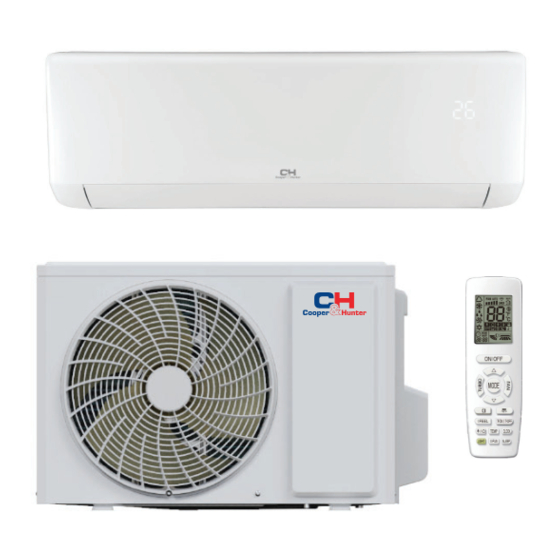
Summarization of Contents
Exception Clauses
Manufacturer Liability Limitations
Lists reasons why the manufacturer is not liable for damages or injuries.
Safety Precautions
Installation Safety Guidelines
Covers professional installation, wiring, grounding, circuit breakers, and power supply requirements.
Operation and Maintenance Safety
Details safe usage by children, cleaning, power cord safety, water usage, repair, and filter handling.
Installation Notice
Installation and Relocation Safety
Covers refrigerant circuit integrity, proper refrigerant, recovery, flammable gas, and wiring precautions.
Installation Location Selection
Basic Requirements
Lists unsuitable locations for installation to prevent malfunctions.
Indoor Unit Placement
Specifies requirements for indoor unit placement and mounting.
General Installation Safety
Outlines general safety rules for electrical connections and installation.
Indoor Unit Installation
Step 1: Choose Installation Location
Recommends and confirms the installation location with the client.
Step 2: Install Wall-Mounting Frame
Details how to hang and fix the wall-mounting frame on the wall.
Step 3: Open Piping Hole
Describes how to make the hole for the refrigerant pipes.
Step 4: Outlet Pipe Routing
Explains how to route the condensate drain pipe from the indoor unit.
Step 5: Connect Indoor Unit Pipes
Guides on connecting the refrigerant pipes to the indoor unit bellmouth.
Indoor Unit Installation
Step 6: Install Drain Hose
Instructs on connecting the drain hose to the indoor unit's outlet pipe.
Step 7: Connect Indoor Unit Wire
Provides instructions for connecting the power and control wires to the indoor unit.
Indoor Unit Installation
Step 8: Bind Up Pipes
Details how to bind the pipes, power cord, and drain hose together for management.
Step 9: Hang the Indoor Unit
Guides on lifting and securing the indoor unit onto the wall-mounting frame.
Cleaning and Maintenance
Cleaning the Indoor Unit Surface
Recommends using a soft cloth for cleaning the indoor unit's exterior.
Filter Cleaning Procedure
Provides step-by-step instructions for cleaning the air filters.
Maintenance Checks
General Phenomenon Analysis
Troubleshooting guide for common issues with the indoor unit and general operation.
Component Identification
Indoor Unit Parts
Identifies the key components of the indoor unit.
Display Panel Indicators
Shows the indicators on the indoor unit's display panel.
Remote Controller Operation
Buttons Overview
Introduces the buttons on the remote controller and their functions.
Display Icons Explained
Explains the meaning of various icons displayed on the remote control screen.
Remote Controller Operation
Basic Button Functions
Explains the ON/OFF, MODE, and FAN buttons for basic operations.
Remote Controller Operation
Advanced Button Functions
Explains the TURBO, temperature adjustment, and swing functions.
Remote Controller Operation
Timer and Special Function Buttons
Details the T-ON/T-OFF, SLEEP, and X-FAN functions.
Remote Controller Operation
Additional Functions and Settings
Explains I FEEL, CLOCK, LIGHT, Child Lock, and temperature display functions.
Remote Controller Operation
Specialized Functions and Battery Replacement
Covers WIFI, Double Self Clean functions, and battery replacement.
Test and Operation
Check After Installation
Lists checks to perform after the unit installation is completed.
Test Operation Procedure
Details the steps for conducting a test operation after installation.
Component Identification
Outdoor Unit Parts
Identifies the air inlet and outlet of the outdoor unit.
Installation Notice
Installation and Relocation Safety
Covers refrigerant circuit integrity, proper refrigerant, recovery, flammable gas, and wiring precautions.
Outdoor Unit Installation
Step 1: Fix the Support of Outdoor Unit
Guides on selecting a location and fixing the outdoor unit support.
Step 2: Install Drain Joint
Instructs on installing the drain joint for specific outdoor unit models.
Step 3: Fix Outdoor Unit
Details how to place and secure the outdoor unit onto its support.
Step 4: Connect Indoor and Outdoor Pipes
Guides on connecting the pipes between the indoor and outdoor units.
Outdoor Unit Installation
Step 5: Connect Outdoor Electric Wire
Provides instructions for connecting the power and signal wires to the outdoor unit.
Step 6: Neaten the Pipes
Guides on routing and securing the refrigerant pipes along the wall.
Test and Operation
Use Vacuum Pump
Details the procedure for using a vacuum pump to evacuate the system.
Leakage Detection
Explains methods for detecting refrigerant leaks using a detector or soap water.
Connection Pipe Configuration
Pipe Length Standards
Specifies standard, minimum, and maximum lengths for connection pipes.
Additional Refrigerant Charging
Provides table for calculating extra refrigerant based on pipe length.
A: Cut the Pipe
Instructions on how to cut the refrigerant pipe to the correct length.
Pipe Expanding Method
B: Remove Burrs
Guides on removing burrs from the cut pipe to prevent contamination.
C: Fit Insulating Pipe
Instructions for fitting an insulating pipe onto the refrigerant pipe.
D: Fit Union Nut
Details how to install the union nut on the connection pipe.
E: Expand the Port
Explains how to expand the pipe port using an expander.
F: Inspection
Guides on checking the quality of the expanded port.
Specialist's Manual
Flammable Refrigerant Installation Checks
Covers checks for installations using flammable refrigerants, ventilation, and fire safety.
Electrical Component Safety and Repair
Details safety checks, capacitor discharge, and repair procedures for electrical components.
Refrigerant System Checks
Covers checking for refrigerant presence, leak detection, and equipment.
Specialist's Manual
Component and System Safety
Covers safe repair of intrinsically safe components, cabling, and leak detection methods.
Decommissioning and Recovery Procedures
Outlines safe decommissioning, refrigerant recovery, and labelling.
Specialist's Manual
Recovery and Handling
Details procedures for recovering refrigerant, handling compressors, and proper disposal.















Need help?
Do you have a question about the PRIMA PLUS CH-S24XN8 and is the answer not in the manual?
Questions and answers